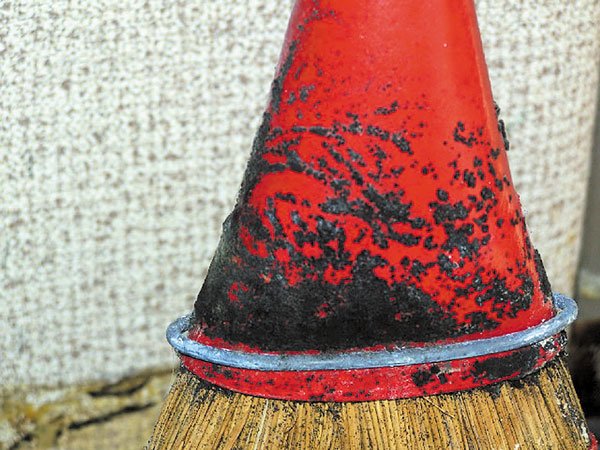Gilroy
– Two years ago Pat Vickroy was diagnosed with asthma. He often
experiences shortness of breath, fatigue, coughing and watery eyes.
Sometimes his joints ache. On the onset of these conditions,
Vickroy, a 50-year-old physical education teacher, thought it was
due to aging.
Gilroy – Two years ago Pat Vickroy was diagnosed with asthma. He often experiences shortness of breath, fatigue, coughing and watery eyes. Sometimes his joints ache. On the onset of these conditions, Vickroy, a 50-year-old physical education teacher, thought it was due to aging. But now, he believes his health problems were caused by conditions he endured while working in a portable on the Brownell Academy campus.
Vickroy contacted Jeff Gopp, Gilroy Unified School District’s manager of maintenance and operations, via email last August regarding testing for Indoor Air Quality after noticing the presence of mold in his office.
His emails went unacknowledged and phone calls unreturned.
“Every time I’d go in there I’d get as sick as a dog,” Vickroy said.
He began keeping a journal of his health from January of 2004 to April 2005 and noticed a pattern forming: Weeks of fatigue and feeling ill, combining for more than 104 days of sickness.
The portable Vickroy’s office occupied, J11, is one of 36 the district agreed to abandon in 1999 in order to receive state funding for the construction of Antonio Del Buono School. All 36 were from the former Jordan Elementary School campus.
According to state documents, the district was required to dispose of the portables within 180 days, unless filing a request to extend usage. GUSD’s extension was granted until May 1, 2004.
The district was unable to provide documentation from the Office of Public School Construction approving an additional extension.
By December 2004, Vickroy was fed up with the district’s lack of response and contacted Gilroy Teachers Association President Michelle Nelson.
Both Nelson and Vickroy informed Brownell Academy assistant principal Jim Gama and Gopp once again and requested the room be tested for mold.
In an e-mail from Gopp to Gama, it was revealed that no one was ever supposed to occupy J11 and that it was supposed to be used for storage only.
Gama assured Vickroy he would be moved the following semester after winter break. In the meantime, Vickroy photographed the mold in his room, taking pictures of the ceiling, carpet and broom.
He never directly alerted Principal Suzanne Damm of the problem and did not remove the moldy items from the room because he wanted tests to identify which species of mold he had been exposed to.
On Jan. 7, 2005, Vickroy was removed from J11 after Linda Piceno, the district’s assistant superintendent of human resources, visited the facility. She informed Steve Brinkman, GUSD’s assistant superintendent in charge of facilities, that it was necessary he be moved immediately.
The computer equipment in J11 was also moved, but without being cleaned. Vickroy’s conditions did not improve after the move and he requested Gopp to test both the new and old room for mold.
“In the past, I have had people in the district deny that there were problems, that problems even existed,” Nelson said. “Here there was clear evidence that there were problems and that they needed serious attention.”
Weeks later, no tests had been conducted and Vickroy decided to perform them himself. He returned to J11 on Jan. 31 and collected two surface samples – one from a broom handle and another from a mold colony on the carpet. He had both analyzed by Benchmark Environmental Engineering in San Jose.
The results identified six different species of molds present in the room, several which are considered to be allergens. Benchmark could not determine a correlation between the surface samples and airborne amplification without a full mold investigation.
In February, Vickroy e-mailed the results to Piceno who then passed them on to Brinkman and GUSD Superintendent Edwin Diaz.
Nelson met with Diaz and requested IAQ tests be conducted in J11 and that the equipment inside the new room be cleaned. Diaz ordered Gopp to respond.
The IAQ report Gopp returned with on April 1 turned out to be the same samples Vickroy had taken, and sent to a different company for analysis. Nelson contacted the district and demanded another test be performed – by Benchmark. The test was scheduled for April 12.
During this time, Vickroy received a copy of a IAQ test the district had performed at Brownell in 2002 by Raibon & Colbert Associates. The report indicated that room J11 had visible water damage and was categorized as a priority one, or P1, facility.
A room designated a P1 is of top concern and usually requires remediation. Five other Brownell rooms were given P1 rankings. Currently, 331 students enter those classrooms each day, as well as nine staff members. Next week, IAQ tests are scheduled for those rooms.
This summer, the district plans to retire all of the remaining Jordan portables at Brownell.
Some of Raibon & Colbert’s recommendations for the district included: Providing a copy to each project site, informing site staff of the findings and proceeding with site walk–through inspections at all sites with a P1 designation.
“We didn’t even know there had been a testing,” Vickroy said. And the walk–throughs? “That never occurred to my knowledge. We never saw anyone come walk through.”
GUSD did adopt the Environmental Protection Agency’s Tools for Schools IAQ program, one of the company’s suggestions.
Feeling suspicious, Vickroy revisited J11 on April 11, the day before the test was scheduled, and discovered that it had been cleaned.
“The room was spotless,” he wrote in an e-mail to Nelson. “Steam cleaned carpets, equipment, desks, book shelves, moldy broom, broken moldy ceiling tiles … GONE. The room had the ventilation system working and on, with a new regulator on the wall. Something that NEVER worked the entire time we were in this room … ALL to prepare for the Benchmark testing at 9:00 tomorrow morning.”
Nelson immediately contacted Diaz. Her concern was that any results would now be invalid and would not provide information about Vickroy’s exposure.
Diaz assured her that the room was not supposed to be cleaned.
“Jeff ordered it to be cleaned,” Brinkman said.
Gopp ordered a subordinate staff member to wash the walls and carpet, and dispose of the materials in the room.
“This individual was just doing what he was ordered to do,” Brinkman said.
He stated that the room was “absolutely not” supposed to be cleaned before the test.
Brinkman was one of the last individuals contacted about the situation, when he probably should have been the first – since he is in charge of facilities.
“I’m not going to try to wriggle out of it,” he said. “I am responsible … There are any number of places where we could have stepped up.”
After Vickroy was moved in January, Brinkman believed the situation had been remedied.
“Obviously I was wrong,” he said. “There’s no real excuse on my part.”
Bryan Buller, chief operations officer at Benchmark explained that although the room was cleaned, it was probably not done using mold remediation methods. Benchmark found mold levels inside were still slightly higher than outside.
“Regardless of what they did, it was still elevated,” he said.
Because there are more than 300,000 types of mold and individuals respond to mold at varying levels, there is no universal standard determining how much should be considered a health risk.
However, according to Benchmark’s report, an international rule of thumb states that, “In well–maintained public and commercial buildings, indoor airborne fungal concentrations will be lower than outdoor concentrations.” Individuals allergic to mold may develop asthma and pulmonary emphysema, in addition to skin irritations and bronchiospasms.
Vickroy has filed for workman’s compensation and is undergoing medical testing to identify which molds he has been exposed to.
“We should have been notified earlier on that our health was at risk,” he said. “They put children in there and other staff members at risk.”
Still hurt by the district’s response, he is confused about what steps to take next.
“I’m in turmoil constantly about what to do,” Vickroy said. “How far I should push this, what type of legal action I should take?”
Gopp is currently on paid leave and was unavailable for comment.
District e-mail correspondence
From: Jeff Gopp 12/20/2004 4:25pm
To: Jim Gama CC: Suzanne Damm
RE: Mold
I cannot assure anyone that we can rid that room of any organic growth. I believe we need to move the inhabitants out of that room. … I was told before you were located at Brownell, Jim that the room was for storage only and no one would ever be located there. Maybe we can find him a place at another site but get him out of there and use the room for storage only. We need to explain that to Pat and now Michelle. I have worked hard to correct the IAQ issues in the district and do not wish to breach that trust.
•••
From: Patrick Vickroy Sent Wed 12/22/2004 8:07pm
To: Jim Gama
Subject: RE: Mold
From your message, it sounds like the room does have mold. When was this discovered and why were we not told? Year after year I have been getting sick (cold symptoms) that would not go away for month at a time. … If Jeff knew that the room had mold and allowed us to remain in this room after I notified him to check … would be a major professional and human blunder!
•••
From: Michelle Nelson Sent: Thu 12/30/2004 10:05pm
To: Patrick Vickroy
Subject: RE: Mold
The district is very much aware that the buildings at (the old Jordan portables) should not be occupied. If anyone says differently, they are lying.
•••
From: Edwin Diaz Sent: 3/3/2005
To: Michelle Nelson; Jeff Gopp CC: Steve Brinkman
Subject: RE: Jordan portables
Jeff,
I am disappointed that this situation hasn’t been responded to. … After reviewing the testing results provided by Mr. Vickroy, I consider this a high priority and want an immediate response back. When it comes to staff and safety, there is no greater priority!!













